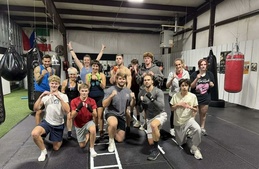
Making Migizi Fly
Championing the Midwest's first tribal raptor rehabilitation center
By Eric Cox | Sept. 4, 2021
America’s first tribal eagle aviary and rehabilitation center east of the Mississippi is perched on the edge of success.
And Traverse City’s Higher Art Gallery (see sidebar) is determined to help the fledgling operation, which announced its intention to establish a facility on tribal land in March but has a long way to go — despite having two major players in northern Michigan wildlife preservation in its corner: locally renowned wildlife rehabilitator and educator Rebecca Lessard and the Little Traverse Bay Band of Odawa Indians (LTBBOI).
Lessard and the LTBBOI have partnered to build a raptor sanctuary on tribal land located west of Vanderbilt, near the tip of the mitt. While a raptor aviary and rehabilitation center isn't unique, it's certainly special for northern Michigan. There are only about eight such tribally-owned facilities in the western United States. This one — the Migizi Aviary and Wings of Wonder Rehabilitation Center — will be the first in the Midwest and East.
JOINING FORCES FOR GOOD
The connection between the work of Lessard, a biologist with 30 years of raptor rehabilitation work under her belt, and local Native American tribes goes back many years. Members of the LTBBOI and the Grand Traverse Band of Ottawa and Chippewa Indians — both of the Anishinaabe people — have consistently lead ceremonies honoring Lessard's release of rehabilitated raptors back into the wild.
The word migizi, in fact, is Anishinaabemowin for eagle. And the bald eagle, in particular, is of special relevance to Native Americans. Migizi, who flies so high and sees so well and is so near the Creator, is considered by the Anishinaabe to be a messenger to the Great Spirit, reporting the progress of the Anishinaabe and their adherence or denial of the divine guidance given them.
Lessard’s reverence of eagles closely reflects that of local Native American communities. Now, with barely a few months of retirement under her belt, 67-year-old Lessard is about to embark on a massive project whose foundations were laid long ago in her animal-loving heart.
Like many people, Lessard grew up loving her pets, a dog and a cat. But things changed when she was 8 or 9. Out of the blue, her parents surprised her by allowing her to get a small pet turtle at a local pet shop. That little reptile stimulated her young mind. Lessard began devouring library books about animals, which in turn led to hamster and gerbil adoptions and subsequent maze-training experiments.
Horses, too, piqued her interest. She began riding regularly, savoring her time with animals and competing in Western shows. In high school she was on to volunteer work at dog kennels, again soaking up knowledge before engaging in obedience trials and dog shows.
It seemed young Rebecca was into all mammals … but not really birds?
Nope.
“We didn’t even have a bird feeder,” she says, laughing.
By college, deciding what major to choose was pretty easy: biology. Away at school in Northern Minnesota, Lessard fell in love with the woods and, subsequently, insects. That led to her minor in entomology.
Birds still weren’t on her radar.
A TURNING POINT
Years after college, still working with mammals and other creatures, Lessard was persistently pushed by a veterinarian friend to help rehabilitate a red tail hawk. She declined again and again, but the vet friend insisted.
“I knew it was a tremendous opportunity,” she tells Northern Express. “But, my kids were really young at the time, and we were homeschooling. I knew the commitment it would take, and I thought to myself, ‘I know nothing about raptors!’ and, frankly, I was rather afraid of these birds.”
Yet, she reluctantly agreed. In 1990, Lessard held the injured hawk for the first time. Like her pet turtle moment, this experience had an equally dramatic effect.
“I was absolutely mesmerized by its eyes and its strength,” she said, her voice belying a sincere reverence. “That sense of strength and power — it totally changed my life in that moment. It was absolutely life-changing.”
From that moment on, Lessard was hooked. She learned everything she could, earning all the state and federal certifications necessary to handle and care for raptors.
“I did training at the Kalamazoo Nature Center, which made me even more curious. I spent time at the Minnesota Raptor Center. They took me under their wing. I was there from sunup to sundown, and they eventually gave me the combination to the back door. They let me do everything.”
After settling in northern Michigan, Lessard convinced her husband to let her construct a large flight pen on their property. He agreed, and they obtained the necessary permits. It would be their service back to the world, the couple reasoned, rehabilitating raptors. They could serve a maximum of five birds annually, they speculated.
She founded the nonprofit Wings of Wonder and went to work taking in and caring for injured, sick, and orphaned hawks, eagles, and owls.
“Ignorance is bliss,” says Lessard, recalling how naive she'd been to assume she'd limit her annual care to five. “The first year we ended up with 12 birds. Naturally, we built another flight pen.”
But, after 10 years, the operation had taken more than it had given. On call for injured birds practically 24/7, the Lessards’ threads were getting a tad bare.
“It was draining us pretty substantially financially and really impacting our lives,” she says. “We had birds everywhere. I still can’t believe we did that volume — 30, 50, 80 birds a year.
“Life was crazy. It was just insane. After 10 years, I started realizing that this was not how I wanted to live my life.”
LEAVING THE NEST
Aside from the ceaseless rehabilitation projects and administrative work associated with founding Wings of Wonder, Lessard was still regularly traveled the state educating people on raptors and raptors' roles in the world. While the education component was a critical part of her mission, it only compounded her work-life imbalance.
“My job started being in the office more and more,” she says. “But, I’m an outdoor person. I wanted to work with birds and rehabilitate birds. So we downsized the operation. I got out of the office, and the last 15 years have been amazing.”
She had pretty much retired from full-time rehab work when a persistent idea cropped up again and again in her mind: a tribally-owned aviary aimed at rescue and rehabilitation. About 10 years ago Lessard had begun networking with a tribal aviary in Oklahoma and wondered why Northern Michigan couldn’t have a similar facility.
At that time, according to Lessard, the U.S. Fish and Wildlife Service had a grant program that helped fund tribal aviaries. The Grand Traverse Band of Ottawa and Chippewa Indians (GTB), then a proponent of the aviary project, endorsed a grant application. Unfortunately, that same year the federal government reduced that particular grant funding by 66 percent, and the GTB grant was denied.
“But I was still trying to plant the seed of the idea and push it,” she said. “And I kept notes of everything that transpired.”
AN IDEA WITH WINGS
Her diligence paid off. Longtime eagle advocates and friends of her Wings of Wonder nonprofit, the LTBBOI became increasingly interested — even after the federal grant program was permanently nixed. Lessard’s productive and professional 20-year relationship with Doug Craven, LTBBOI’s Director of Natural Resources, was something worth pursuing, she thought.
After all, Lessard reminded LTBBOI volunteers about the aviary’s potential each and every time they delivered an injured bird to her Empire home or released a rehabilitated bird in memorable Anishinaabe fashion.
“It reached the top of [the LTBBOI's priority] list a few years ago, and we entered into some serious conversations — conversations that were more committed and determined,” she says. “Last year we really started the ball rolling. [Craven] found money to hire a native-owned architectural firm in Kalamazoo, which created some great conceptual drawings of The Migizi Aviary.”
For this group, COVID-19 was merely a minor speed bump on the road to completion. They convened Zoom meetings and kept making progress. With blueprints in hand and site surveying already underway, Lessard and LTBBOI are now actively pursuing the necessary construction funds.
REALIZING THE DREAM
But, what will that money — approximately $700,000 — purchase?
According to the Wings of Wonder organization, The Migizi Aviary & Rehabilitation Center will be equipped to care for injured, sick, or orphaned birds of prey. An emergency surgery facility and critical care unit are also part of the plan.
Outdoor enclosures that allow for rehabilitation and conditioning will also be included, as well as a 100-foot curved aviary for raptors that can’t be released back into the wild. Made of locally harvested timber, this structure will provide a home for birds that are permanently mentally or physically disabled.
The project will be divided into three phases: construction of the containment areas, construction of a medical facility and related spaces, and finally, the sprawling, curved aviary for resident birds.
To some, such a facility might seem a good place to visit — to see majestic creatures we rarely spot, and when we're lucky enough to, are often perceived only as moving dots in the sky. While a limited number of visitors will be allowed inside the aviary, Craven told Northern Express the installation will be more of a closed facility and less of a tourist attraction, not open to the public.
Disappointing? Sure. But keep in mind the mission: serving and saving raptors — not people. Both Craven and Lessard emphasize that bald eagles, hawks, and other raptors require privacy to feel comfortable, a condition critical to any creature's ability to recuperate. The prospect of noisy, gawking visitors further stressing already struggling birds simply isn’t a viable scenario.
Yet, according to Craven, The Migizi Aviary & Rehabilitation Center will also provide an expanded educational component, above and beyond what the LTBBOI already provides nearby Pellston schools.
Craven said the tribe has a popular sturgeon program in place, one that gives individual classrooms a tank with a juvenile sturgeon that students must care for and study before releasing the fish back into local waterways. A similar program, he said, could be done with bald eagles.
The LTBBOI has done extensive monitoring and management of bald eagles, tracking them with miniature cell phone backpacks, charting their nesting habits, and logging mortality rates.
Craven said when the tribe started its bald eagle preservation efforts back in 2005, there were about 13 nests on tribal lands, and the bird was on the endangered species list. Fast-forward 16 years, and there are now roughly 30 nests on its lands, and America’s national bird is no longer endangered, thanks in large part to widespread Native American preservation efforts underwritten by a mix of tribal funds, federal grants, and private donations.
Such endeavors are precisely where the paths of Lessard and Craven and the LTBBOI crossed – Lessard with her immense love and care for the animals, and Craven and his people’s reverence for all living creatures, but especially Migizi, the vigilant, white-headed overseer of the Anishinaabe.
Craven and others from LTBBOI delivered dozens of sick, injured or orphaned raptors into Lessard’s care, each gaining the other’s respect through years of consistent, like-minded actions that benefit an animal they all love and respect.
Since the land was provided by LTBBOI, all that remains are the construction costs and related expenses. So far, they have about $100,000, but they’re chasing a variety of funding, including U.S. Fish and Wildlife grants, funds from the Bureau of Indian Affairs, and, of course, private donations.
“There are a lot of moving parts, but we’re moving in the right direction,” Craven said, his enthusiasm evident. “In terms of funding, we’re certainly looking for all interested parties.”
Help Migizi Happen
Want to help make a reality? You can support it by attending the opening of the Artists for Wings of Wonder fundraising exhibit, which will take place 6pm–8pm Friday, Sept. 10. The work of more than 30 artists will be showcased at the event — the theme: raptors, of course — and attendees will be treated to two complimentary glasses of wine, hors d' oeuvres catered by Chow Bella Catering, and live music provided by local singer, cellist, and banjo player Arianna Wasserman. Also featured at the event: a dance performance by Eagle Spirit Dancers founder Roberta Shalifoe. Can't make it that night? All of the artwork for the exhibit will go live in Higher Art Gallery's online shop on Sept. 11, and you can continue to see the pieces in person at the gallery through Sept. 30.
Find Higher Art Gallery at 219 E. Front St., in Traverse City. For ticket information, visit www.higherartgallery.com. To learn more about The Migizi Aviary & Rehabilitation Center, visit www.wingsofwonder.org.
Trending

Building the Life You Want
Who needs a life coach? While people seek out life coaches for a variety of reasons, one theme is almost always present, co… Read More >>
Nominations are Open for Fascinating People 2026!
That’s right folks, it’s time to think about the most wonderful, curious, eclectic, fantastic, and fascinating p… Read More >>
Winter Trails Day 2025
Celebrated throughout the North, Winter Trails Day invites kids and grown-ups alike to discover the fun of trail-based snows… Read More >>


